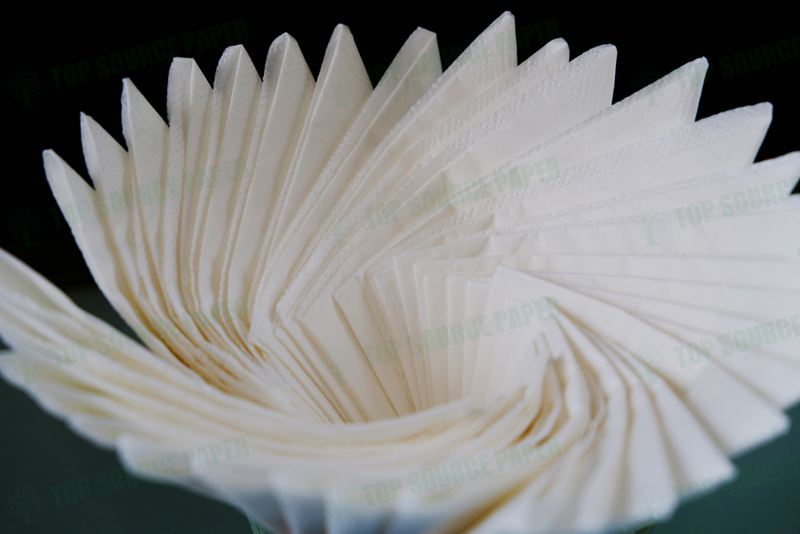Every year, the hospitality industry generates millions of tons of paper waste—much of it from conventional napkins that end up in landfills. As consumers and businesses prioritize sustainability, biodegradable napkins are emerging as a “no-brainer” solution for eco-conscious dining without compromising quality or performance.
Top Source Paper specializes in high-absorbency, chemical-free biodegradable napkins that break down safely while maintaining the softness and durability restaurants demand. From FSC-certified materials to compostable packaging, we’ll explore how switching to sustainable napkins can reduce environmental impact while meeting operational needs.
The Rise of Biodegradable Napkins: Why Now?
In today’s eco-conscious world, biodegradable napkins are gaining traction like never before. With consumers becoming more aware of environmental issues, the demand for sustainable dining options has skyrocketed. “Green” disposable products, like biodegradable napkins, are no longer a niche market—they’re a necessity. This shift isn’t just about trends; it’s driven by stricter regulations on single-use plastics and a collective push toward sustainability.
“Biodegradable napkins offer a simple yet impactful way for businesses to reduce their environmental footprint while meeting consumer expectations.”
Growing Consumer Awareness of Environmental Issues
People are more informed than ever about the harm caused by traditional disposable products. From social media campaigns to documentaries, the message is clear: single-use plastics are out, and eco-friendly alternatives are in. Biodegradable napkins, made from materials like bamboo or recycled paper, align perfectly with this mindset. They break down naturally, reducing landfill waste and ocean pollution.
The Impact of Regulations on Single-Use Products
Governments worldwide are cracking down on single-use plastics, with bans and taxes pushing businesses to adapt. For the hospitality and catering industries, this means finding compliant alternatives fast. Biodegradable napkins not only meet these regulations but also appeal to environmentally conscious customers. It’s a win-win for compliance and brand reputation.
How Biodegradable Napkins Meet Sustainability Goals
Unlike traditional napkins, which can take decades to decompose, biodegradable versions break down in months under the right conditions. This makes them a key player in corporate sustainability initiatives. For businesses, switching to biodegradable napkins is a tangible step toward reducing their carbon footprint—one that customers notice and appreciate.
Market Trends: Adoption in Hospitality and Catering
Restaurants, hotels, and event planners are leading the charge in adopting biodegradable napkins. Why? Because today’s diners care about sustainability as much as they care about quality service. Offering green disposable products enhances the dining experience while showcasing a commitment to environmental responsibility. It’s a small change with big branding benefits.
Biodegradable Napkins vs. Traditional Napkins: A Comparison
| Feature | Traditional Napkins | Biodegradable Napkins | Decomposition Time | Consumer Preference |
|---|---|---|---|---|
| Material | Virgin paper/plastic blends | Bamboo, recycled paper, or plant-based fibers | N/A | N/A |
| Environmental Impact | High (landfill accumulation) | Low (breaks down naturally) | N/A | N/A |
| Decomposition Time | 20+ years | 3-6 months | N/A | N/A |
| Cost Premium | Low | 10-20% higher | N/A | N/A |
| Consumer Preference (2023 Survey) | 30% | 70% | N/A | N/A |
For businesses like Top Source Paper, this trend represents a golden opportunity. By offering customizable biodegradable napkins, they help clients align with sustainability goals while standing out in a competitive market. The shift isn’t just about materials—it’s about transforming dining experiences and reinforcing brand values.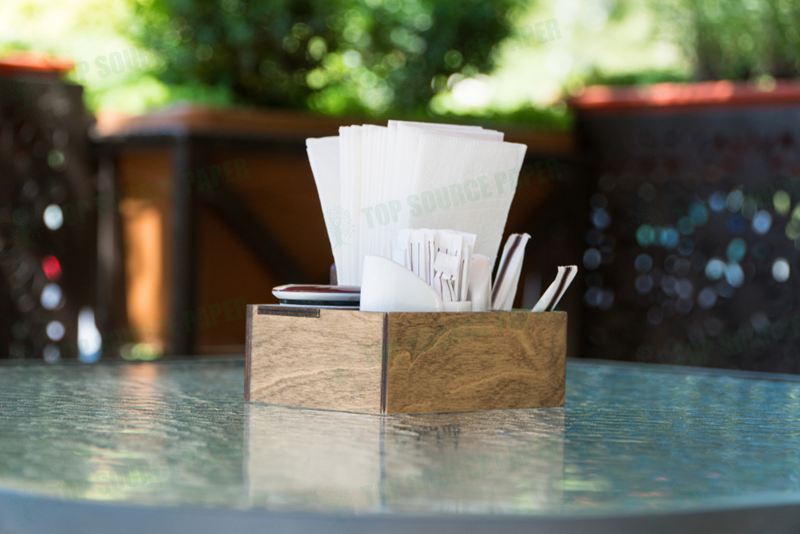
What Makes a Napkin Biodegradable? Material Composition and Production
Ever wondered what makes biodegradable napkins different from regular ones? It all comes down to the materials and how they’re made. Unlike traditional napkins that contribute to landfill waste, biodegradable napkins use eco-friendly materials that break down naturally. This makes them a smart choice for businesses looking to reduce their environmental impact while meeting customer demand for sustainable dining options.
“Biodegradable napkins combine responsible material sourcing with chemical-free production to create truly sustainable disposable products.”
FSC-Certified Paper: Ensuring Responsible Forestry
Many biodegradable napkins start with FSC-certified paper, which guarantees the wood comes from responsibly managed forests. This certification means trees are replanted, wildlife is protected, and workers’ rights are respected. For businesses, using FSC materials shows customers you care about the entire lifecycle of your products – from forest to table.
Bamboo Fibers: A Renewable Resource
Bamboo is becoming a superstar in sustainable napkin production. Why? Because it grows incredibly fast – some species shoot up 3 feet in a single day! Bamboo fibers create soft, durable napkins without depleting resources. Plus, bamboo requires no pesticides and little water, making it one of the most eco-friendly materials around.
Recycled Content: Closing the Loop
Some biodegradable napkins give used paper a second life through recycling. This “closed-loop” approach reduces waste and saves energy – recycling paper uses 60% less energy than making new paper. At Top Source Paper, we carefully process recycled fibers to ensure they meet the same high standards as virgin materials, proving sustainability doesn’t mean sacrificing quality.
Chemical-Free Production: Reducing Pollution
True biodegradable napkins avoid harsh bleaches and dyes that can harm the environment. Instead, manufacturers use oxygen-based bleaching and natural coloring. These gentler processes mean cleaner wastewater and safer decomposition. It’s this attention to detail that sets apart premium sustainable napkins from greenwashed alternatives.
Biodegradable Napkin Materials Comparison
| Material | Renewability | Decomposition Time | Water Usage | Carbon Footprint |
|---|---|---|---|---|
| FSC-Certified Wood Pulp | High (with replanting) | 2-6 months | Moderate | Medium |
| Bamboo Fiber | Very High (fast regrowth) | 1-4 months | Low | Low |
| Recycled Paper | N/A (reused material) | 1-3 months | Very Low | Very Low |
| Conventional Paper | Variable (often unsustainable) | 20+ years | High | High |
| Plastic-Blended | None (petroleum-based) | 100+ years | High | Very High |
Understanding what goes into biodegradable napkins helps businesses make informed choices. At Top Source Paper, we combine these sustainable materials with rigorous quality control to create napkins that perform beautifully while protecting the planet. Whether you need FSC-certified, bamboo-based, or recycled-content napkins, we offer customizable solutions that align with your sustainability goals.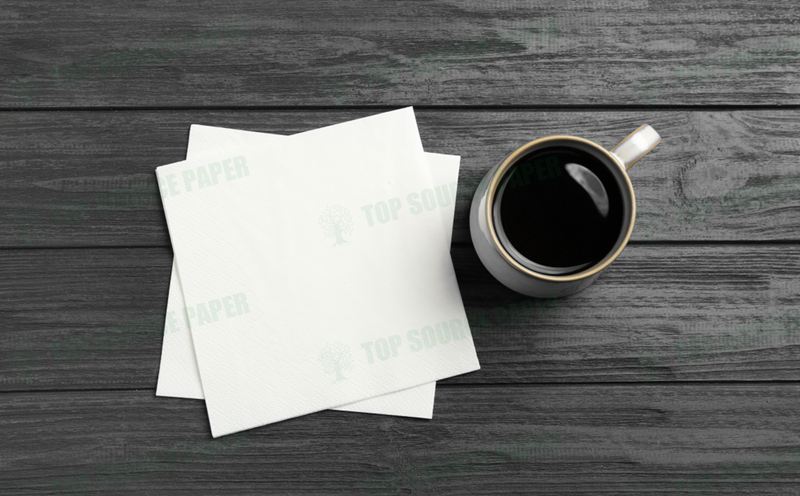
The Environmental and Economic Benefits of Switching to Biodegradable Napkins
The shift to biodegradable napkins isn’t just about being eco-friendly – it’s a smart business move that pays off both environmentally and financially. As consumers become more environmentally conscious, businesses that adopt sustainable practices like using biodegradable napkins gain a competitive edge. These eco-friendly alternatives offer tangible benefits that go beyond just “feeling good” about being green.
“Switching to biodegradable napkins can reduce a business’s waste output by up to 80% while enhancing brand reputation among eco-conscious consumers.”
Reducing Landfill Waste and Pollution
Traditional napkins can take decades to decompose in landfills, releasing methane as they break down. Biodegradable napkins, made from materials like bamboo or FSC-certified pulp, decompose in months rather than years. This significantly reduces the strain on landfills and minimizes harmful greenhouse gas emissions. For businesses using large quantities of napkins, this switch can dramatically cut their contribution to landfill waste.
Lowering Carbon Footprint: From Production to Disposal
The environmental benefits of biodegradable napkins extend throughout their entire lifecycle. Their production typically requires less energy and water than conventional napkins, and they don’t rely on petroleum-based plastics. When disposed of properly, they break down into natural elements without leaving toxic residues. This complete eco-cycle makes them a truly sustainable choice for businesses aiming to reduce their overall carbon footprint.
Cost Savings Through Bulk Purchasing and Waste Reduction
While biodegradable napkins may cost slightly more per unit, businesses can achieve significant savings through bulk purchasing and reduced waste disposal costs. Many suppliers, including Top Source Paper, offer discounted rates for large orders. Additionally, because biodegradable napkins are often more compact and efficient to ship, businesses can save on storage and transportation costs compared to bulkier conventional options.
Enhancing Brand Image with Sustainable Practices
Today’s consumers actively seek out businesses that share their environmental values. Using biodegradable napkins sends a powerful message about a company’s commitment to sustainability. This can lead to increased customer loyalty, positive word-of-mouth, and even premium pricing opportunities. For restaurants and hotels, it’s an easy way to differentiate themselves in a competitive market while doing good for the planet.
Environmental and Economic Impact Comparison
| Factor | Traditional Napkins | Biodegradable Napkins | Impact Difference | Business Benefit |
|---|---|---|---|---|
| Decomposition Time | 20+ years | 3-6 months | 98% faster | Lower waste disposal costs |
| Production Energy | High | Low-Medium | 30-50% less | Aligns with sustainability goals |
| Shipping Volume | Bulky | Compact | 20-30% less space | Lower storage/transport costs |
| Customer Perception | Neutral | Positive | +25% brand favorability | Increased customer loyalty |
| Regulatory Compliance | Risk of future bans | Future-proof | No compliance concerns | Long-term cost certainty |
At Top Source Paper, we understand that switching to biodegradable napkins is both an environmental and business decision. That’s why we offer high-quality, cost-effective solutions that help businesses make this transition smoothly. Our biodegradable napkins deliver exceptional performance while supporting your sustainability goals – proving that doing good for the planet can also be good for your bottom line.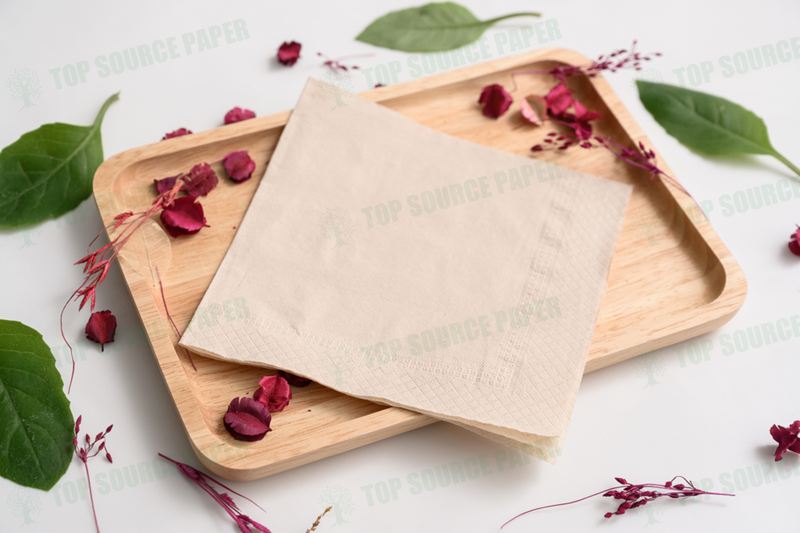
Choosing the Right Biodegradable Napkins: Factors to Consider
Selecting the perfect biodegradable napkins involves more than just picking eco-friendly options – it’s about finding products that meet your specific needs while staying true to sustainability principles. Whether you’re outfitting a restaurant, hotel, or catering business, understanding these key factors will help you make an informed decision about biodegradable napkins that balance performance with environmental responsibility.
“The right biodegradable napkins combine functionality, sustainability, and brand alignment to create a complete dining experience that customers appreciate.”
Absorbency and Softness: Balancing Performance and Sustainability
High absorbency doesn’t have to come at an environmental cost. Modern biodegradable napkins use advanced materials like bamboo fibers that offer exceptional liquid absorption while maintaining softness. Consider your typical use cases – casual dining might prioritize softness, while barbecue restaurants may need maximum absorbency. Top Source Paper’s napkins achieve this balance through specialized fiber blends that deliver both qualities without compromising sustainability.
Size and Ply: Matching Napkins to Specific Applications
From cocktail napkins to dinner-sized options, choosing the right dimensions affects both functionality and waste reduction. Single-ply napkins work for light use, while 2-3 ply options provide more durability for messier meals. Custom sizing available through Top Source Paper’s OEM services ensures you get napkins perfectly suited to your establishment’s needs, reducing unnecessary paper waste while maintaining quality service.
Certifications and Standards: Ensuring Authenticity
Look for FSC certification and other eco-labels that verify the napkins’ environmental claims. These certifications guarantee responsible sourcing and manufacturing processes. Top Source Paper’s products meet international standards, providing documentation that helps businesses communicate their sustainability efforts to eco-conscious customers with confidence.
Packaging Options: Eco-Friendly Delivery Solutions
Complete your sustainable solution with packaging that matches your napkins’ eco-credentials. Options include recycled paper wrappers, compostable plastic alternatives, or bulk dispensers that minimize packaging waste. Custom branding on packaging reinforces your establishment’s commitment to sustainability while maintaining a professional presentation.
Biodegradable Napkin Selection Guide
| Factor | Casual Dining | Fine Dining | Takeout | Specialty Uses |
|---|---|---|---|---|
| Recommended Size | 12″x12″ | 18″x18″ | 9″x9″ | Custom sizes |
| Ideal Ply | 1-2 ply | 2-3 ply | 1 ply | 2-3 ply |
| Absorbency Level | Medium | High | Low | Extra High |
| Certifications Needed | FSC Basic | FSC Premium | FSC Basic | Industry Specific |
| Packaging Type | Bulk Dispenser | Individual Fold | Takeout Packs | Custom Solutions |
Choosing biodegradable napkins is an investment in both your business’s operational efficiency and environmental values. Top Source Paper’s customizable options ensure you get precisely what you need – whether that’s ultra-absorbent napkins for busy restaurants or elegant, soft options for fine dining. With our expertise in sustainable paper products, we help businesses make the switch seamlessly while enhancing their brand’s eco-friendly reputation.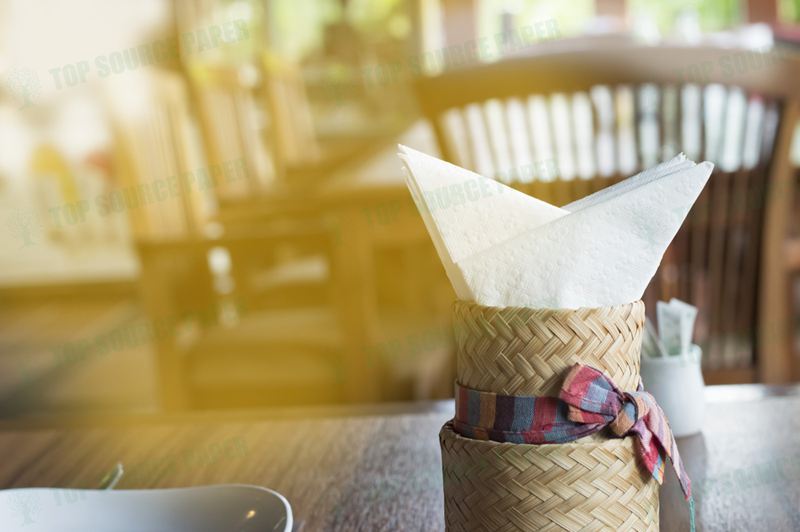
Biodegradable Napkin Disposal and the Future of Sustainable Tableware
As the world moves toward more sustainable dining solutions, understanding proper disposal methods for biodegradable napkins becomes crucial. These eco-friendly alternatives offer more than just reduced environmental impact – they represent a shift toward circular economy principles in the food service industry. Let’s explore how to maximize their benefits through proper disposal and look ahead at emerging sustainable tableware trends.
“Properly composted biodegradable napkins can return valuable nutrients to the soil in as little as 90 days, completing nature’s cycle.”
Composting Biodegradable Napkins: At Home and Commercially
True biodegradable napkins break down best in composting systems. Home composters should look for napkins certified for residential composting, while commercial operations can process larger quantities through industrial facilities. The key is ensuring napkins are free from food contamination and mixed with the right balance of green and brown materials. Top Source Paper’s napkins are designed to decompose efficiently in both environments, making them a versatile choice.
Municipal Waste Systems and Biodegradable Products
Not all waste systems can handle biodegradable napkins equally. Some municipal composting programs accept them, while others may route them to landfills where decomposition slows significantly. Businesses should coordinate with local waste management to determine the best disposal method. As infrastructure improves, we’re seeing more cities develop specialized processing for compostable food service items like biodegradable napkins.
Innovations in Sustainable Tableware Materials
The future of sustainable dining extends beyond napkins to include cutting-edge materials like mushroom-based packaging, seaweed films, and agricultural waste composites. These innovations complement biodegradable napkins to create complete eco-friendly dining sets. Top Source Paper is actively researching these next-generation materials to offer clients comprehensive sustainable solutions that meet evolving consumer expectations.
The Role of Biodegradable Napkins in a Circular Economy
Biodegradable napkins exemplify circular economy principles by transforming waste into resources. When properly composted, they enrich soil rather than polluting ecosystems. Forward-thinking businesses are using them as part of zero-waste initiatives that resonate with environmentally conscious customers. This approach turns everyday items into powerful sustainability statements that enhance brand value.
Biodegradable Napkin Disposal Methods Comparison
| Disposal Method | Decomposition Time | Infrastructure Needed | Nutrient Recovery | Ideal For |
|---|---|---|---|---|
| Home Composting | 2-6 months | Basic compost bin | High | Small households |
| Commercial Composting | 1-3 months | Industrial facility | Very High | Restaurants/caterers |
| Municipal Landfill | 12+ months | Standard waste system | Low | Areas lacking alternatives |
| Anaerobic Digestion | 3-6 weeks | Specialized plant | Medium (energy recovery) | Large institutions |
| Worm Farming | 4-8 weeks | Vermiculture setup | Excellent | Urban farms/schools |
The evolution of biodegradable napkins reflects broader changes in how we approach disposable products. At Top Source Paper, we’re committed to staying ahead of these trends by developing products that meet both current needs and future sustainability standards. By choosing our biodegradable napkins, businesses invest in solutions that satisfy today’s eco-conscious consumers while preparing for tomorrow’s circular economy.
Conclusion
After a decade in the paper industry, I’ve seen firsthand how small changes—like switching to biodegradable napkins—can make a big impact. It’s not just about reducing waste; it’s about meeting the growing demand for sustainability without sacrificing quality or performance.
At Top Source Paper, we’ve built our reputation on delivering eco-friendly solutions that don’t cut corners. Whether it’s FSC-certified materials or compostable packaging, our goal is to help businesses transition seamlessly to greener options. The shift to biodegradable napkins isn’t just a trend—it’s a “game-changer” for the hospitality industry.
If you’re ready to align your brand with sustainability, the right partner can make all the difference. Let’s create something better—for your customers and the planet.
FAQ
Q1: What are biodegradable napkins made of?
A1: Biodegradable napkins are typically made from plant-based fibers such as bamboo, sugarcane, or recycled paper that decompose naturally over time.
Q2: How do biodegradable napkins break down?
A2: They break down through microbial activity, especially in the right conditions found in industrial or well-managed home composting facilities, leaving behind natural elements.
Q3: Are biodegradable napkins eco-friendly?
A3: Yes, they are designed to reduce environmental impact by minimizing long-term waste and utilizing sustainable materials and chemical-free production methods.
Q4: Do biodegradable napkins decompose in home composting systems?
A4: Many biodegradable napkins can decompose in home composting setups; however, the rate of decomposition may vary based on material composition and compost conditions.
Q5: What are the environmental benefits of using biodegradable napkins?
A5: They help reduce landfill waste, lower carbon footprints, and conserve resources by breaking down naturally and reducing reliance on synthetic materials.
Q6: Are biodegradable napkins as strong as regular napkins?
A6: Modern biodegradable napkins are engineered to be durable for everyday use, though performance can vary depending on the material and manufacturing process.
Q7: What certifications should I look for when choosing biodegradable napkins?
A7: Look for certifications such as FSC-certified paper and compostability standards that verify the product is made without harmful chemicals and is environmentally safe.
Q8: Can biodegradable napkins clog compost bins?
A8: When used according to disposal guidelines, biodegradable napkins typically break down without clogging compost bins, especially in properly managed compost systems.
External Links
- Biodegradable Sanitary Napkins: A Sustainable Approach
- Biodegradable Sanitary Napkins Study
- Sustainable Materials Management (SMM)
- Biodegradable and Compostable Plastics
- Environment and Waste Management – OECD
- Biodegradable plastics: How long do they last?
- Biodegradation of Paper Napkins in Composting Environments
- Biodegradable Plastic Innovation – BBC News Science & Environment

